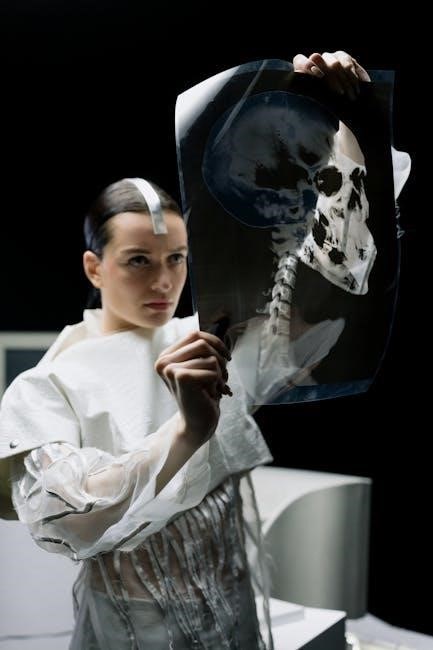The introduction to the MRI ordering guide provides essential information and guidelines for healthcare professionals to order appropriate MRI scans for their patients using
- lists
effectively always.
Importance of MRI in Medical Diagnosis
Magnetic resonance imaging (MRI) plays a crucial role in medical diagnosis‚ providing valuable information for healthcare professionals to make informed decisions about patient care. The use of MRI in medical diagnosis has become increasingly important due to its ability to produce high-quality images of internal structures‚ including organs and soft tissue. This allows for the detection of various conditions‚ such as tumors‚ injuries‚ and vascular diseases. With the help of MRI‚ healthcare professionals can diagnose and monitor conditions more accurately‚ leading to better patient outcomes. The importance of MRI in medical diagnosis is evident in its widespread use in hospitals and medical facilities‚ where it is used to guide treatment and improve patient care. By utilizing MRI technology‚ healthcare professionals can provide more effective and targeted treatment‚ ultimately leading to improved health outcomes for patients. MRI is a vital tool in medical diagnosis‚ and its importance will continue to grow as technology advances.

General Guidelines for MRI Procedures
General guidelines for MRI procedures involve specific
- protocols
and precautions to ensure patient safety and accurate results always.
Contrast Agents in MRI Scans
Contrast agents play a crucial role in MRI scans‚ enhancing the visibility of specific areas or structures within the body. The use of contrast agents‚ such as gadolinium-based contrast agents (GBCAs)‚ is carefully considered and guided by specific protocols to ensure patient safety. According to guidelines‚ patients receiving GBCAs for spinal imaging are subject to contrast guidelines‚ which outline the necessary precautions and monitoring required. In certain cases‚ such as evaluating SI joints‚ additional orders for MRI of the pelvis may be necessary‚ and the use of contrast agents may be indicated. The selection of contrast agents and the decision to use them are critical components of the MRI ordering process‚ and healthcare professionals must carefully weigh the benefits and risks of contrast agent use in each individual case‚ using tables and
- lists
to inform their decisions and ensure optimal patient outcomes‚ with further information available on the topic.
MRI Scans for Specific Body Parts
Guidelines outline MRI scans for specific body parts using
- lists
and links to provide essential information always.
MRI of the Cervical and Thoracic Spines
MRI of the cervical and thoracic spines is a diagnostic technique used to evaluate the spinal cord and surrounding structures. The use of contrast agents may be necessary in certain cases‚ such as multiple sclerosis.
In these situations‚ the contrast agent is used to enhance the visibility of the spinal cord and surrounding tissues‚ allowing for a more accurate diagnosis.
The guidelines for MRI of the cervical and thoracic spines outline the specific protocols and procedures for imaging these areas‚ including the use of contrast agents and the positioning of the patient.
The MRI scan is typically performed using a high-field strength magnet and a specialized coil to optimize image quality.
The resulting images are then interpreted by a radiologist to diagnose conditions such as herniated discs‚ spinal stenosis‚ and spinal cord injuries.
The information provided by the MRI scan is used to guide treatment and management of spinal conditions‚ and to monitor the effectiveness of treatment over time.
Overall‚ MRI of the cervical and thoracic spines is a valuable diagnostic tool for evaluating spinal conditions and guiding treatment.
MRI of the Pelvis and SI Joints
MRI of the pelvis and SI joints is a diagnostic technique used to evaluate the pelvic region and sacroiliac joints. When evaluating SI joints‚ an additional order for MRI of the pelvis is necessary to provide a comprehensive assessment;
The MRI scan is used to diagnose conditions such as sacroiliitis‚ osteitis‚ and fractures‚ as well as to evaluate the surrounding soft tissues.
The use of contrast agents may be necessary in certain cases to enhance the visibility of the pelvic structures.
The guidelines for MRI of the pelvis and SI joints outline the specific protocols and procedures for imaging these areas‚ including patient positioning and image acquisition techniques.
The resulting images are then interpreted by a radiologist to diagnose conditions and guide treatment.
The MRI scan is a valuable diagnostic tool for evaluating the pelvic region and SI joints‚ and is often used in conjunction with other imaging modalities to provide a comprehensive diagnosis.
The information provided by the MRI scan is used to guide treatment and management of pelvic conditions‚ and to monitor the effectiveness of treatment over time‚ using various
- techniques
and
- protocols
.

Specialized MRI Services
Advanced diagnostic and interventional radiology services are offered using
- various
techniques and equipment always effectively online;
Advanced Diagnostic and Interventional Radiology Services
Advanced diagnostic and interventional radiology services are offered by various healthcare providers‚ including Jefferson Radiology‚ which provides accurate diagnoses and personalized care using cutting-edge technology and expert radiologists. The services include computed tomography (CT) scans‚ magnetic resonance imaging (MRI) scans‚ and other diagnostic imaging procedures. These services are designed to help healthcare professionals diagnose and treat a wide range of medical conditions‚ from cancer and cardiovascular disease to neurological disorders and musculoskeletal injuries. The use of advanced diagnostic and interventional radiology services can help improve patient outcomes and reduce the need for invasive surgical procedures. By providing detailed images of the body’s internal structures‚ these services can help healthcare professionals develop effective treatment plans and monitor patient progress over time. Overall‚ advanced diagnostic and interventional radiology services play a critical role in modern healthcare‚ enabling healthcare professionals to provide high-quality patient care and improve health outcomes.

MRI in Neurosurgery and Neuroscience Care
MRI guides neurosurgical procedures and neuroscience care using
- lists
and advanced imaging techniques effectively always online.
Stereoscopic Navigation-Controlled Display of Preoperative MRI
The use of stereoscopic navigation-controlled display of preoperative MRI has revolutionized the field of neurosurgery‚ allowing for more precise and accurate procedures. This technology enables surgeons to visualize the brain and its structures in three dimensions‚ using
- ordered lists
to guide their movements. By combining preoperative MRI scans with intraoperative 3D ultrasound‚ surgeons can better plan and execute their operations. The display of preoperative MRI scans in a stereoscopic format provides a more immersive and interactive experience‚ allowing surgeons to better understand the complex anatomy of the brain. This technology has the potential to improve patient outcomes and reduce the risk of complications. With the use of
- unordered lists
‚ surgeons can quickly and easily access important information‚ such as the location of critical structures and the extent of tumor growth. Overall‚ the stereoscopic navigation-controlled display of preoperative MRI is a powerful tool in the field of neurosurgery.

and Recommendations for MRI Ordering
Guidelines for Commonly Ordered MRI Procedures and Indications
Guidelines for commonly ordered MRI procedures and indications are provided to assist healthcare professionals in making informed decisions. The use of MRI scans is essential in diagnosing various medical conditions‚ and it is crucial to follow established guidelines to ensure accurate diagnoses. A list of commonly ordered MRI procedures is available‚ including scans for the brain‚ spine‚ and joints. Each procedure has specific indications‚ and healthcare professionals must carefully evaluate patients to determine the most appropriate scan. The guidelines also provide information on the use of contrast agents‚ which can enhance the visibility of certain structures or lesions. By following these guidelines‚ healthcare professionals can ensure that patients receive the most effective and efficient care possible. The guidelines are regularly updated to reflect advances in MRI technology and new clinical evidence‚ and they are available online for easy access. Additionally‚ the guidelines include information on the preparation and safety precautions for MRI procedures.
